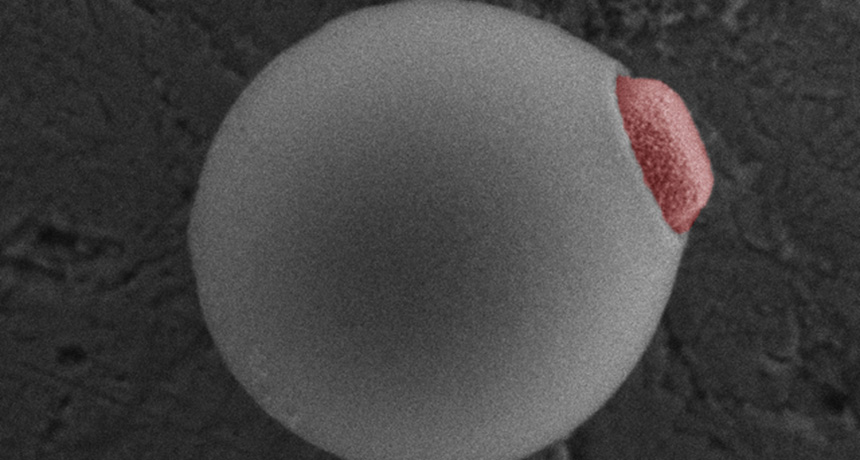
AGAINST THE FLOW In a new experiment, micrometer-sized particles sensed their direction and propelled themselves upstream. Each particle (one shown in this micrograph) was made of a plastic sphere engulfing a hematite cube (colored red).
Stefano Sacanna
- More than 2 years ago
Human-made microbeads don’t always go with the flow.
Under certain conditions, the artificial particles can align themselves with a fluid’s flow and then swim upstream, researchers report May 1 in Science Advances. These particles represent a small step toward making more elaborate ones that can be used to target and treat disease, the scientists say.
“This particle is simple. It’s iron and plastic, yet it can feel flow and go against it similar to some microorganisms,” says study coauthor Jérémie Palacci, a physicist at the University of California, San Diego. “It’s mimicking what we see in nature.”
Sperm and the parasitic bacterium Pseudomonas aeruginosa are well-known for their abilities to swim upstream (SN: 4/6/13, p. 15). One seeks a shot at creating new life; the other attempts to reach a potentially sweet spot to start a new colony (possibly inducing a serious bladder infection in the unsuspecting host). Bacteria and other microorganisms are also masters at sensing chemical and physical changes in their environment so they can move closer to food or away from toxins. Palacci says for the last decade or so scientists have tried to design “smart” particles to do the same thing to deliver drugs to targeted organs or to bust through blockages in blood vessels.
Two challenges have stymied those efforts. One is developing a body-safe fuel source; the other is endowing particles with the ability to sense and react to their environment. The new work addresses the second challenge: It provides a way to direct particles within an external flow, says Giovanni Volpe, a physicist at Bilkent University in Ankara, Turkey.
In the new work, Palacci and colleagues mimic the physics that P. aeruginosa uses to swim upstream into the bladder. They used a micrometer-size particle made of a tiny cube of hematite, the mineral form of the iron oxide Fe2O3, embedded in a plastic sphere. The hematite protrudes from the sphere slightly, like a head. The team stuck several of these hematite-headed particles in a glass capillary and then let a mix of water and hydrogen peroxide slowly flow through the tube. In response, the particles went with the flow, like a stick in a river.
Shining a blue light through the capillary, however, changed their behavior. They did a U-turn: Their hematite heads faced into the flow, and the particles propelled themselves upstream. The light made the hematite quicken the reaction that splits hydrogen peroxide into water and oxygen. This breakdown generated differences in the amounts of oxygen and hydrogen peroxide in the water. Those differences pulled the hematite heads toward the glass wall and also propelled the particles. At the same time, the flow pushed the particles’ plastic tails. As a result, the particles faced into the flow, aligned themselves with it and propelled themselves upstream.
Volpe says some of the physics described in the new work, such as the self-propulsion of the particle and the turning of its tail, lays the groundwork for designing particles to swim upstream in blood vessels. This particular particle and its hydrogen peroxide fuel, however, are not compatible with the body, he notes.
Palacci concedes that hydrogen peroxide is not something you want to inject into your body. Still, he says, the fact that the team created a particle that senses its environment and propels itself upstream makes the idea of using smart particles in medicine seem a little bit less like the stuff of science fiction.
TURNING IN A micropipette’s nozzle (large circle, center) pulls liquid toward it, creating a flow. When blue light shines on the liquid, made of water and hydrogen peroxide, the human-made particles (tiny circles) face toward the flow and start swimming into it, forming a circle around the tip of the pipette. When the light is turned off briefly, the particles go with the flow and are flushed away from the pipette. Turning the light on again makes them swim toward the flow.
Credit: J. Palacci et al/Science Advances 2015







